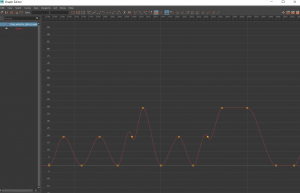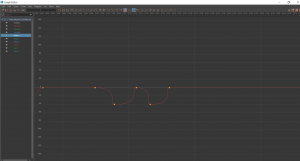Our major challenge for this semester was to ensure that the animations were smoother. Last semester while working and testing out the animations we realized the animations were causing a lot of wear and tear on the animatronic which was a major distraction and made him look robotic rather than like a real character or puppet. Therefore, the goal for this semester was to start working on making the animations smoother along with adding the character traits and performance in the animations. To do this we began with reviewing all the animations from the last semester and Niharika went through the Weigl documentation again to determine how to utilize the show controller software to make the animations smoother after conversion. She then decided to use the different range of motion using the principles of animation for timing and spacing to experiment with different speeds and accelerations. She began first with the animations in Maya to make them smoother and the second step was to use the show controller software features to make the curves for the animation smoother using some inbuilt features. The steps that we undertook while using the two approaches are discussed below:
1. FOR MAYA: We first began smoothing out the animations in Maya by starting with a new show. In order to do this Niharika used different range of motion like for example for the HEAD TURN function the full range of motion is 0-90 degrees and Niharika therefore used different range like 40 degrees, 20 degrees, 75 degrees etc. to make the animations smoother as well as add the performance to the animation. By using the different range of motion at different speeds like for example if the head turns at an angle of 45 degrees in 24 frames i.e. 1 second then it would give a different acceleration as compared to when the head turns at an angle of 65 degrees in 24 frames (1 second). By implementing the different speeds for different range of motion for all the functions, Niharika was able achieve different accelerations and make the animations smoother.
After making the iterations another important phase of making the animations smoother was Testing as it helped us determine if the strategy that we were using was working or not and if the changes being made were causing further problems. Niharika did a lot of tests for different animation iterations on the animatronic and this testing helped her discover new tricks and solutions for making the animations further smoother. She also referred to the reference video from the previous semester for the range of motion test that we did on the animatronic using the calisthenics (Please refer to the video below to determine the ideal speeds and acceleration that can be achieved.
Another important contribution in smoothing out the animations was made by the using the graph editor. The graph editor was mostly responsible for making the animations smoother as using the graph editor Niharika could make the curves smoother and the curves are the most important when it comes to smoothing out the animations. She had to ensure that the curves are smooth, consistent and are not linear as the acceleration can vary using S and C curves instead of linear curves. Therefore, she used the different features and tools provided by Maya to smooth the curves and make them in the shape of C and S curves and not linear. Niharika also noticed while creating the iterations that the graphs used to develop certain weird curve shapes that would cause jerks. An example of this can be seen in the image below.


Niharika then fixed some of these problems using the tools provided with the graph editor and after conversion we noticed that the Weigl 3D converter was able to capture the shape of the curves and we then utilized the show controller software to further make the animations smoother.
2. FOR WEIGL SHOW CONTROLLER SOFTWARE: After smoothing out the animations in Maya using the graph editor, we then used the show controller software Conductor Pro given to us by Weigl to make the animations smoother by using their inbuilt features.
The best thing about the Conductor software is that some of the features are like the graph editor in Maya and it allowed Niharika to modify the curves. Niharika took advantage of the feature in conductor pro that allows to change the interpolations of the curves from linear to curve which helped to capture the accurate data from Maya as before when we were not using this feature the curves would be represented as linear which would be the reason for jerks even after making the animations smoother in Maya. Therefore on changing the interpolation in Conductor Niharika was able to retain the C and S curve shapes from Maya which helped in making the animation smoother. However, there was also a disadvantage of using the feature as it would although turn the animation curves into S and C curves, but it would also add certain weird shapes in between and therefore Niharika had to go in manually and clean up the data to ensure that there were no jerks occurring. Testing played an important role in determining this as on playing the animations on the animatronic it would help us to know if the weird curve shapes were causing any jerks. After cleaning up the data and changing the curve interpolations we discovered that the animations looked smoother.
By following these steps using Maya and show controller software we were able to make the animations smoother. If you would like to know about the entire animation process in further detail, please follow the link: https://www.etc.cmu.edu/projects/miracle-workshop-2/index.php/support/in-depth/animation-in-depth/ to gain in-depth knowledge about the animation pipeline and how we made the animations smoother.